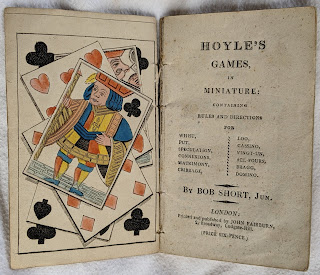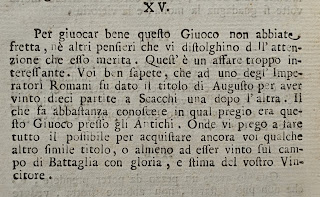Until a flurry at year end, 2021 was a quiet year, even though it was the year that my Hoyle collection surpassed that of the Bodleian Library, at least according to my idiosyncratic way of counting. The depth of my collection makes it hard to find new things.
The most fun purchase was a parcel I bought at auction. The auction house described it as follows:
Playing card, gambling and other interest books to include Beeton's Book of Acting Charades, The Mott St. Poker Club 1888, Ten days at Monte Carlo at the Bank's Expense by V.B., Middleton's Astronomy and the Use of Globes 1862, Cavendish on Whist, Hoyle's Games, Systems and Chances by R.W. Richardson, signed by the author and signed note from the author to Lord Braye, Potter on Gamesmanship and The pawnbrokers act 1872 by Francis Turner.
I wrote them to ask about the Hoyle, and it turned out there were two copies of Hoyle Made Familiar by Robert Hardie, a book I complained in the essay "Kicking and Screaming into the 19th Century." I already had one of them, but the other was a rarity, with only one other copy recorded, of course at the Bodleian. For the parcel, I bid what I was willing to pay for the rare Hoyle and won the lot. Shipping from the UK cost nearly as much as the books themselves.
Unpacking the box reminded me of the old days of going to a second-hand book shop and sitting on the floor, going through the gaming books. Yes, the gaming books were invariably on a bottom shelf! As in the book shop, going through the parcel was a multi round game of "junk" or "treasure." There were 20 books on gaming, only a few of which were identified in the auction catalogue. I ended up adding eleven books to the collection. Of course, the rare Hoyle was the highlight, even with (or perhaps because of) the crude frontispiece:
 |
Hoyle Made Familiar (1852)
|
There were other nice books:
- A first edition of Round Games at Cards by Henry Jones, who wrote under the pseudonym "Cavendish" (London: de la Rue 1875).
- A ninth edition of Cavendish on Whist (London: de la Rue 1872). I knew that the tenth edition included an important chapter on the history of whist that did not appear in the eighth edition. I had never seen a ninth edition before and now know that the tenth was the first with the historical notes. I've written about Cavendish many times, identifying him as the successor to Hoyle in one essay. We'll see a particularly interesting Cavendish item below.
- An early edition of Boaz on the Laws of Bridge (London: de la Rue 1898). In 2020, Thierry Depaulis (with the help of Philippe Bodard, Edward Copisarow, and Dave Walker) published an article in The Playing Card identifying Boaz as the pseudonym of Ernest de la Rue, a member of firm Thomas de la Rue & Co. which manufactured playing cards and, as you will have noticed, published gaming books.
The parcel also included books I plan to get rid of. Is anyone interested in the Pawnbroker's Act of 1872? Charades? Globes?
The next item is a manuscript on the game of whist, likely from the late 18th century:
 |
Regles...de Wisht
|
The four-page manuscript is printed on interesting paper. This back-lit image shows a watermark of a crowned shield with a horn inside over the name of the paper-maker, C & I Honig, who was active in the Netherlands from the early 18th century into the 19th:
 |
C & I Honig watermark
|
I placed a higher resolution photograph on my
web site. I found a similar watermark online from a
drawing at the Morgan Library and was curious if the paper could be dated from the watermark. I queried the booklists Exlibris-L and SHARP-L and received many interesting replies. One respondent pointed out two letters from Thomas Jefferson in the Gravell Watermark Archive with similar Honig watermarks,
here and
here.
Another engaging reply was from Ian Christie-Miller, author of the recent book Revealing Watermarks. He said that if could send him front- and back-lit images without moving the paper or camera, he could extract the watermark more clearly. I sent him the two images below:
 |
| back-lit |
 |
| front-lit |
[Aside: if you click on one of the above photos to enlarge it, you can use the arrow keys to toggle between the two pictures and see how they line up.]
Ian used digital subtraction to remove the text and sent me an image essentially of the paper alone:
 |
C & I Honig paper
|
I've shared the text with some French friends who collect and study whist. They were struck by several unusual spellings: "wisht" for "whist", "a tout" for "atout", "robert" for "robre" and more. Their thought was that the manuscript was not copied from a book, but the author wrote down rules he heard.
Both the paper and the rules appear to be from the late 18th or early 19th century, but it is difficult to be more precise.
As promised, back to Cavendish. I purchased a letter from Henry Jones on stationery with his printed address, dated January 16, 1891. The unidentified recipient had written a letter to The Field, a British monthly treating field sports and games, of which Cavendish was the card editor. The original letter apparently complained about the lack of uniformity at whist, that is, the proliferation of conventions (partnership agreements) governing card play. Cavendish replied that the writer's proposed scheme for regulation "has no chance whatever of adoption" and could not recommend that the letter be printed in The Field. Cavendish suggested a more open-ended query--whether the lack of uniformity does call for a remedy.
 |
Cavendish letter p1
|
 |
Cavendish letter p2-3
|
 |
Cavendish letter p4
|
The writer did take Cavendish's suggestion and wrote a second letter to The Field which was published on January 31, 1891. There we learn that the author was W. H. Collins, best known for his leadership of the British Lawn Tennis Association. He gives an example of the lack of uniformity:
First hand [holding] King, queen, knave, ten. Some players lead the ten under all circumstances; others the king with four and the knave with five or more.
and continues with another half dozen specifics. All four cards would have equal trick-taking power-- the choice of which to play is a matter of partnership agreement, a subject I discuss in the essay "The Nature of Gaming Literature (part 2)."
More generally, Collins notes:
[I]n the present stage of whist development, half one's time when playing with strangers is taken up in discovering to what particular school they belong, and how far their reading is up to date.
Cavendish replied in The Field:
It is to be regretted that so many points of difference exist in whist play, but it appears to us to be a necessity of the case. It must be borne in mind that within the last few years changes have taken place in the game which amount to a revolution. In cannot be expected that the whole body of whist players will accept these changes at once, and in their integrity. It will take at least a generation to settle what is good in the proposed changes.
Alas, Cavendish's prediction did not come true. As the 19th century gave way to the 20th, whist died out in favor of early forms of bridge. The 1898 Laws of Bridge by Boaz, mentioned above, foreshadowed the future.
There are a few more items either in transit or coming up at auction before year end, so perhaps there will be a second part to this essay. I find it striking that two of the items described here are manuscripts, the rules of whist and the Cavendish letter. I find myself more and more attracted to manuscript material. The items are unique, unlike printed books which may be produced in hundreds or thousands. I am not alone. As digitization brings more and more printed texts online, collectors, both institutional and private, are seeking out what cannot be found elsewhere.
Did I mention that one of the items in transit is another manuscript on the game of trictrac?



.jpg)












































